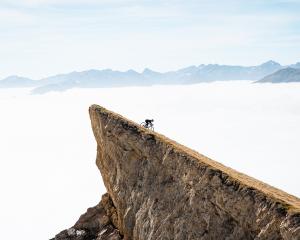Boozer hut is a 10sq m one-room timber-framed dwelling, clad with sheet metal flattened from old steel drums, in the rugged 9400ha Whakaari Conservation Area, near Glenorchy.
The shack contains the bed, table, coal range and bric-a-brac left behind by the one or two long-gone miners, who used it sporadically while working their claims.
The hut was built at the head of the Bonnie Jean Stream.
Doc capital works project manager Richard Struthers, Doc carpenter Jim Croawell and contracted builder Doug Henderson dug out the hut, braced it internally and stripped it of heavy and historical materials. They camped on site over three weeks to do the work, inautumn.
Pilot Alfie Speight used a helicopter to lift Boozer Hut about 400m to its new timber piles on the popular track to the Bonnie Jean Hut, within Whakaari, in early May.
The crew returned in two-day trips to refit the hut, including recycled flooring and a window replaced in character, as well as reinstating artefacts exactly where they had been, according to photographs.
Mr Struthers said Boozer Hut had a "high level of historical interest", due to its days as a shelter for scheelite miners since the beginning of the last century.
"It's a museum piece, a snapshot of time and of how miners lived up there.
"It's available for day-time entry, but not for overnight accommodation."
The project cost $10,000 to relocate the hut and fly in materials by helicopter, as well as to overhaul the shack and pay for staff.
Boozer hut was the 10th miner's hut restored by the department over the past four years, in a programme estimated to cost $80,000.
Mr Struthers said there was one more to salvage, the battery manager's hut at the Glenorchy scheelite battery, on Mt Judah Rd, off the Glenorchy-Queenstown Rd.
Scheelite, an ore of tungsten, was used to harden steel and was extremely valuable to the Allied armaments industry during both world wars.
Asked why the department was going to the time, trouble and expense of saving the huts, Mr Struthers said: "It's historic heritage of early mining in New Zealand, in the same way our gold mining heritage is important.
"It's one of only two places scheelite was mined in New Zealand, so it represents a unique and intact history and is worth preserving."
Advertisement













